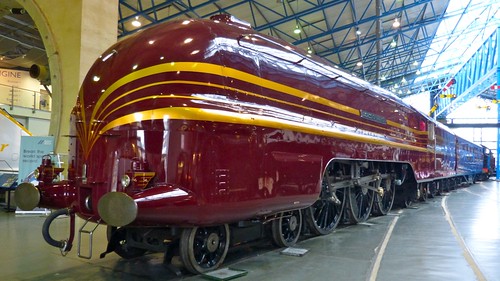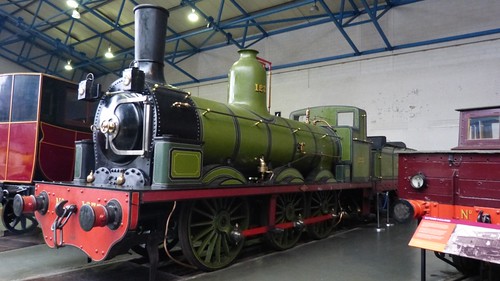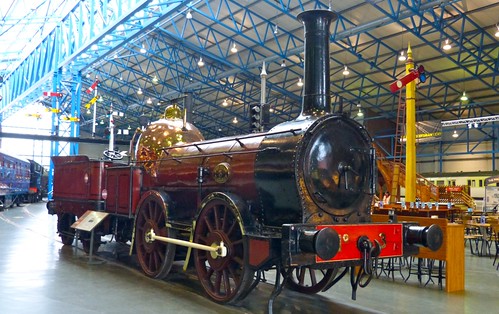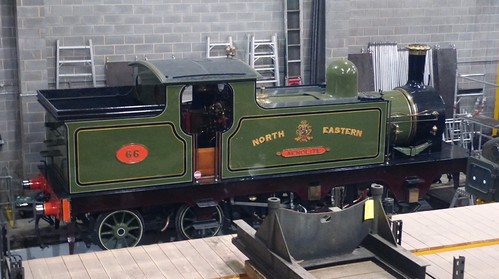We must start with the daddy of them all which is George Stephenson’s ‘Rocket’.
Designed and built for the ‘Liverpool & Manchester Railway’ in 1829.
The Rocket is generally recognized as the first modern steam locomotive bringing together the elements that became the the features of all subsequent steam locomotive designs.
The original loco exists in the ‘Science Museum’ whilst the York one is a replica.
After entering the Museum, the first exhibit that greets the visitor is ‘Wren’. An 18 inch gauge 0-4-0ST loco built by Beyer Peacock in 1887 for the ‘Lancashire & Yorkshire Railway’ (LYR).
It was built for use on the ‘LYR’s internal system at their works at Horwich in Lancashire.
Carrying the ‘LYR’ lined locomotive livery, ‘Wren’ was retired in 1963.
No. 4468 ‘Mallard’.
Still after 77 years the holder of the world speed record for steam locomotives at 125.88 mph (202.58 kph).
A member of the A4 Class of locomotives designed by Sir Nigel Gresley for the ‘London & North Eastern Railway’ (LNER). It was built at the ‘LNER’s works at Doncaster in 1938.
Withdrawn in 1963, ‘Mallard’ is one of six of the class that have been preserved.
No. 6229 ‘Duchess of Hamilton’
One of the Princess Coronation Class of locomotives designed by ‘Sir William Stanier’ for the ‘London Midland & Scottish Railways’ (LMS). Built in 1938 at the ‘LMS’ works at Crewe.
Originally built as and today displayed in streamlined condition, the loco ran for many years without the streamlined casing.
For most of its working life it ran on the West Coast Main Line and after being withdrawn it put in many sterling performances in preservation around the country.
No. 3700 ‘City of Truro’ (from time to time it has also carried the number 3717)
Designed by George Jackson Churchward and built by the ‘Great Western Railway’ (GWR) in 1903.
It was a speed record holder in an earlier era having been credited with being the first loco to be timed at over 100 mph.
Withdrawn in 1931 because of the significance of it speed record it was originally donated to the LNER for display in its then new museum at York.
Returned to service in 1957 it worked on various services until being withdrawn again in 1961.
The latest restoration to working order took place in 2004 when it ran in preservation until yet another withdrawal in 2011 but at the time of writing, the NRM has stated that further repairs will take place.
No. 737
A 4-4-0 tender locomotive built for the ‘South Eastern and Chatham Railway’ (SE&CR) as its ‘D’ Class.
Designed by Harry Wainwright, the class which numbered 51 locomotives was built by 5 manufacturers between 1901 and 1907.
Passing to the ‘Southern Railway’ in 1923 and ‘British Railways’ (BR) in 1948, 737 became No. 31737 in BR days being withdrawn by the mid 1950’s.
In my view one of the most elegant loco’s ever built.
No. 245
An 0-4-4T designed by Dugald Drummond for the ‘London and South Western Railway’ as its Class M7 who between 1897 and 1911 built 105 examples.
A successful design used initially on suburban passenger trains and later on branch line work.
Passing eventually to both the ‘Southern’ and ‘British Railways’. No. 245 is one of 2 of the class preserved. The other being at the ‘Swanage Railway’ which the last time I saw it was preserved in ‘BR’ black livery.
No. 1275
An 0-6-0 tender loco designed by William Bouch and built by Dubs & Company of Glasgow for the ‘North Eastern Railway’.
Part of the ‘1001’ Class it was built in 1874. The class had along production life stretching from 1852 to 1875 when a total of 192 examples had been delivered.
This type of design referred to as the ‘long boiler’ dates back to an earlier design by Robert Stephenson in 1842.
All had been withdrawn by 1923.
No.3 ‘Old Coppernob’
Was built by Bury, Curtis and Kennedy of Liverpool for the ‘Furness Railway’ in 1846.
Withdrawn in 1898, it was displayed in a glass case on Barrow station where it was damaged during an air raid in the Second World War.
No.7
A 4-8-4 tender loco built for the ’Chinese Government Railways’ as its Class KF.
Designed by Colonel Kenneth Cantile and built at the Vulcan Foundry in 1935.
A massive piece of machinery, one of 24 built. This loco was presented to the NRM by the Chinese Government and there is another example on display at the Beijing Railway Museum in China.
I have always liked a wheel arrangement where the bogie wheels are the same layout either side of the driving wheels i.e. 2-4-2, 2-6-2, 4-6-4, 2-8-2 and 4-8-4 etc. It always seems to give a loco a more balanced appearance.
No. 66 ‘Aerolite’
Built for the ‘North Eastern Railway’ as a 2-2-2WT in 1869. It was rebuilt as a 4-2-2T in 1892 and further rebuilt to a 2-2-4T in 1902.
At the grouping in 1923, this unusual wheel arrangement was classed as X1. Withdrawn in 1933, it was preserved by the ‘LNER’ at York.
No 2500
One of 37 Stanier designed 2-6-4T loco’s that were built at Crewe in 1934 for the old ‘London Tilbury and Southend Railway’ line that had become part of the LMS in 1923.
Built as 3 cylinder loco’s which provided plenty of power for their role of hauling express passenger trains in and out of London.
No. 2500 was withdrawn in 1961 and is the only survivor.













No comments:
Post a Comment